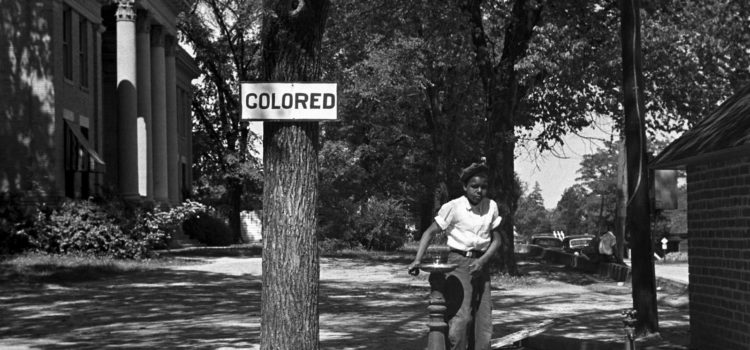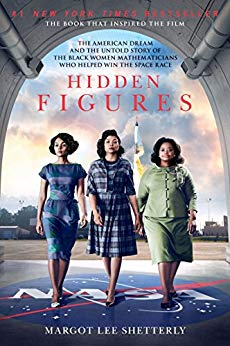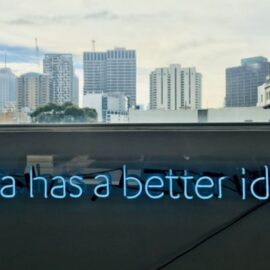

This article is an excerpt from the Shortform summary of "Hidden Figures" by Margot Lee Shetterly. Shortform has the world's best summaries of books you should be reading.
Like this article? Sign up for a free trial here .
What are some Hidden Figures discrimination examples? What kind of discrimination did the women of Hidden Figures face?
Hidden Figures discrimination examples can be found throughout the book. Remember the women were working at NASA while Jim Crow laws were still in effect. Of course, the women of Hidden Figures faced both racial and gender discrimination, making their achievements all the more noteworthy. Read these Hidden Figures discrimination examples to get a sense of just some of the things Katherine, Dorothy, and Mary faced in their quest to build great scientific careers.
Racial Discrimination in Hidden Figures
Despite the job opportunities afforded by NACA, black people still had to face the prejudice of living and working in a segregated city of the American South at the height of the Jim Crow era. Black people had to use separate bathrooms, separate drinking fountains, separate entrances on buses, send their children to separate schools, and live in separate neighborhoods—or face severe repercussions. Indeed, segregation was powerfully entrenched in the nation’s historical experience and was an all-encompassing feature of life in Virginia. In Hidden Figures, racism is evident.
Facing this climate of discrimination, the first generation of West Computers established their own culturally vibrant and cohesive communities all throughout Hampton Roads. Such communities enabled mobile young black families who’d moved to Virginia to keep their morale high and served to welcome and acclimate new waves of black migrants to the region. These Hidden Figures discrimination examples show the adversity the women faced, and just a part of their long fight for equality.
Hidden Figures Discrimination Example #1: A Segregated City
As progressive and forward-looking as Hampton Roads may have seemed at first glance to someone like Dorothy Vaughan, it was still a segregated city of the American South at the height of the Jim Crow era and in Hidden Figures, racism was something the women dealt with on a daily basis. Black people and white people had separate entrances to get on buses, and blacks were expected to give up their seats to whites if the white section was filled. African-Americans who were caught sitting in white sections could be fined, arrested, or even dragged off the bus and beaten by police. These practices even extended to black soldiers in uniform. Indeed, segregation was powerfully entrenched in the nation’s historical experience and was an unmistakable feature of life wherever one traveled, especially in the South.
Hidden Figures Discrimination Example #2: Newsome Park
The new black economic migrants to the region, like Dorothy, settled in a neighborhood called Newsome Park. The community was built during the Depression, a subdivision designed and built “for blacks, by blacks.” It became a focal point of the black community in Hampton Roads, attracting residents from all different occupations and income levels.
Because legal segregation prohibited so many of Newsome Park’s residents from full participation in Virginia’s economy and society, the community (like many other black communities throughout the South) became economically and culturally self-sufficient. Newsome Park featured its own community center with a full kitchen and banquet space, basketball and tennis courts, and a baseball diamond. The shopping center was home to a bustling grocery store, drugstore, barbershop, and even a TV repair shop.
In short, Newsome Park featured all the amenities that the upwardly mobile young black families who’d moved to Virginia needed to keep their morale high and find new sources of community in a new town. As the new black migrants came and settled, they saw that their children became fast friends with the children of the other families who’d recently made their way to Virginia. It’s one of the major Hidden Figures discrimination examples, showing how the women may have worked for one of the biggest organizations in the country, but still were forced to live by Jim Crow laws.
Hidden Figures Discrimination Example #3: Colored Computing
When Dorothy Vaughan arrived at Langley, the bus dropped her off at the West Area of the campus, the space that had been reserved for the new black, female computers (the East Area was set aside for their white counterparts). She found that her new colleagues shared her background in the world of black colleges, alumni associations, and churches. Despite the prejudices and limited opportunities that existed at the time even for white women, these black women had all landed jobs at the world’s premier aeronautical research institution.
One of the biggest Hidden Figures discrimination examples is that of West Computing. White women (former East Area Computers) oversaw the West Computers, parceling out tasks to the various section heads, who in turn subdivided the work among the women in their section of the computing pool. What the women of West Computing were usually working on was a portion of a larger task, some quick piece of calculation that an engineer required for a bigger project.
Langley was a place where colleagues worked closely with one another (often literally close, thanks to the wartime hiring spree) and clerks and computers might rub shoulders with top aeronautics researchers. Yet, because of the color of their skin, the West Area Computers were largely excluded from this collegial atmosphere. Although Executive Order 8802 had mandated fair employment in the defense industry, Langley’s location in the Commonwealth of Virginia forced it to comply with that state’s segregation statutes.
In an example of Hidden Figures racism, this was symbolized most hurtfully by the sign on the table where they sat at the back of the cafeteria that read, “COLORED COMPUTERS.” Although they were ostensibly professionals on par with their colleagues at Langley, they were still treated as something less than equal.
Hidden Figures Discrimination Example #4: Separate Bathrooms
Mary Jackson was a full-fledged Civil Service employee. But the sting of discrimination that she’d known so well growing up in Virginia still followed her to Langley. Once, when she was sent by Dorothy Vaughan on an assignment to the predominantly white East Side, she asked the white computers where she could find the bathroom. The white girls simply laughed at her—Mary was black, so how could they possibly know where her bathroom was? The ugly specter of Jim Crow hurt all the more because it was at Langley, where Mary was supposed to be an equal, working with her colleagues to help her country. But still, absurdly, she was unable to perform her bodily functions in the same bathroom as her white colleagues. Out of the Hidden Figures discrimination examples, this one turns into an opportunity; Mary speaks to “Kaz” Czarnecki about the incident, and he offers her a job working with him instead.
Gender Discrimination in Hidden Figures
For all of the progress that had been made, Langley was still very much a white world, in particular a white man’s world. The women of West Computing may have mastered the intricacies of aerodynamics, but now they faced an even more daunting task: advancing as women in a career that was built and run by men. These Hidden Figures discrimination examples focus on the gender discrimination the women also faced.
Hidden Figures Discrimination Example #5: A Man’s World
The forms of discrimination could be subtle. There was a whole universe of networking, consisting of lunches, cocktail hours, and men-only smoking sessions from which the women of Langley were shut out. Being talented wasn’t enough when they lacked the social capital and access to get their superiors to see it.
The way to get noticed and start getting real credit for one’s work as a computer was to get out of the general computing pool and become assigned to a specific group working on a particular project. This would allow for the development of specialized knowledge, which would make the computer far more valuable to the team than someone with just general knowledge. As NACA moved into space research in the 1950s and 1960s, this kind of specialization would be a key point of difference between the women who made the cut and those that didn’t.
This was illustrated dramatically by the experience of two (white) female computers from East Computing. In 1947, these two women were sent west to the Mojave Desert, along with a small team of fellow Langley employees, to conduct research into the vexing problem of getting aircraft to travel faster than the speed of sound (“breaking the sound barrier”).
Working in this small, detached team and focusing on a singular, mission-oriented project was a game-changer for these two women. When they verified the fact that pilot Chuck Yeager had indeed broken the sound barrier, it brought them a new level of credit and recognition. They had broken a barrier of their own. Other signs of progress were there, as more and more Langley women began to get their names on research reports, a key first step in the career of any engineer.
Hidden Figures Discrimination Example #6: Girls Don’t Go to Meetings
One of the most blatantly gendered Hidden Figures discrimination examples is Katherine’s exclusion from meetings, despite her role on the team. Katherine was helping the senior researchers prepare these reports, which were beginning to be generated at an increasingly steady pace. She took the opportunity to pepper the engineers with questions, both to satisfy her own bottomless curiosity and to demonstrate her intellectual bona fides to the team. But because the topic was so unknown, she was discovering the answers right alongside the engineers. Despite her desire to contribute more to the mission by participating in the editorial meetings, however, she was still excluded from them, being told bluntly by her male colleagues, “Girls don’t go to the meetings.”
Her insistence on being included in the process was notable in an era when, even in the workplace, women were expected to “act like ladies” and patiently wait for assignments to be given to them by their male supervisors. That women might have the same passion for the work as their male colleagues seemed to have crossed no one’s mind. But Katherine was undaunted. For her, it would have been a betrayal of her own confidence and that of the people who had helped her get this far to turn her back on the greatest journey of exploration in human history, simply because she was a woman.
So she persisted. She kept asking to come to the meetings, always showing the utmost respect for her colleagues (which was genuine), but also the confidence that came from knowing that she truly belonged in the room. Her persistence paid off. The engineers couldn’t come up with a rational explanation for why someone so obviously committed to the cause and qualified to take on the challenge shouldn’t be allowed to contribute. In 1958, Katherine entered the editorial meetings of the Aerospace Mechanics Division of NASA.
These are just a few of the many Hidden Figures discrimination examples. In the book, you’ll see just how difficult it was for the women of Hidden Figures, and how their fight for equality helped their careers, but also helped NASA thrive.

———End of Preview———
Like what you just read? Read the rest of the world's best summary of Margot Lee Shetterly's "Hidden Figures" at Shortform .
Here's what you'll find in our full Hidden Figures summary :
- How brave black women were instrumental to the American space race
- How they confronted racism and sexism to forge a better future
- Their enduring legacy in American history







nice but could be shorter.
Was very helpful for a paper over discrimination.
when can I read the rest of the article ? Even with the subscrition, i cant read ather the third example.
Hi Lani! You can read it in the full book guide: https://www.shortform.com/app/book/hidden-figures/preview
this was so helpful for my project